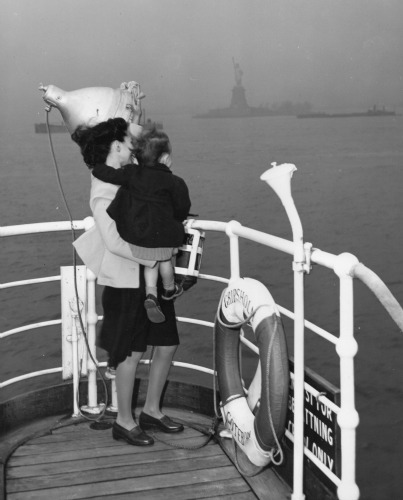Crystal City Texas
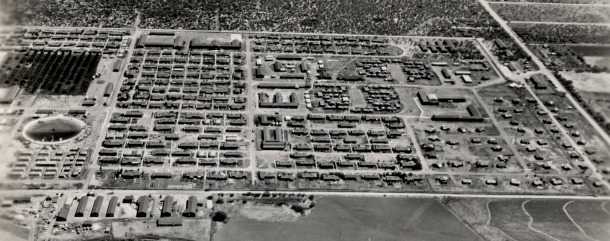
Housing all three Axis nationalities, Crystal City (Family)
Internment Camp was intended to be populated by people of Japanese ancestry and their immediate families. However, on
December 12, 1942, the camp’s first internees to arrive were a mix of German Americans and German Enemy Aliens. On
February 12, 1943, the first group of Latin Americans arrived––also Germans––deported from Costa
Rica. On March 17, 1943, the first group of Japanese American internees arrived. The Immigration and Naturalization (INS)
planned to transfer all German internees to another camp, but the German spokesman asked camp officials if they could remain
because their living conditions here were far better than at previous confinement sites they were held at.
From its inception in mid-1942 through June 1945, Crystal City (Family) Internment Camp
interned 4,751 (this included 153 people born in the camp). The camp’s population peaked at 3,374 on December 29,
1944, more than two thirds of which were of Japanese nationality or ancestry. Approximately 11,507 German Americans were
interned in the U.S. during the war, accounting for 36 percent of the total internments under the DOJ Alien Enemy Control
Unit Program. In addition, an estimated 4,500 ethnic Germans and Italians from Latin America were brought to the U.S. during
the war, as part of the Department of State’s Special War Problems Program, with many held at Crystal City. Millions
of native-born Italians––later naturalized––and their American-born children lived in the U.S. when
the country went to war with the Axis in 1941. In addition, there were also many Italian Enemy Aliens residing in the U.S.,
estimated at nearly 600,000. However, the percentage of Italians, classified as Enemy Aliens and interned during the war
was far smaller than those interned from the Japanese and German American communities. Following the surrender of Fascist
Italy in 1943, most Italian American and Enemy Alien internees were paroled or outright released by the end of that year.
A few Italian Latin Americans, held in very small numbers at Crystal City, remained well after the end of the war.
By late 1942, the U.S. Army realized it needed to focus the efforts of it's Provost Marshal
General's Office on the expected task of guarding hundreds of thousands of Axis Nations [Japan, German, and Italy] prisoners
of war. In response, the DOJ gave the INS further authority to house potentially dangerous Enemy Aliens (including U.S.
citizens) at internment camps throughout the U.S. Early in the war, many detained Enemy Aliens were fathers, and the INS
faced an increasing number of requests from wives and children volunteering to be interned so they might be reunited with
the head of their households. This need to house families together was the genesis of theCrystal
City (Family) Internment Camp. In April 2013, the THC conducted a low-invasive archeological survey in an effort
to gain a better understanding of the camp’s history. This survey is funded through a 2012 grant from the National
Park Service’s Japanese American Confinement Sites Grant Program, and will aid the THC with its National Register
of Historic Places nomination for the confinement site.
What Did The Confinement Site Look Like?
In
Crystal City, the INS looked for a site that was removed from important war production facilities and had good existing water
and electrical services. Noting the pressing need for the camp to open, the INS looked at Crystal City, where the U.S. Government
already owned a large portion of land. During the Great Depression, the Farm Security Administration acquired land on the
outskirts of this small southwest Texas town and built approximately 150 buildings to house migratory agricultural workers.
In early 1942, the U.S. military reviewed the facility as a potential location to establish a training site, but that never
materialized.
When the internment camp opened
in December 1942, the site was approximately 240 acres in size, with 41 small three-room cottages and 118 one-room shelters
(measuring 12x16 feet). Twelve of the original cottages were left outside the “fenced area” (100 acres in size)
for use by official personnel and their families. With an expected increase in population and need for more housing, the
DOJ confiscated an additional 50 acres to the south of the “fenced area,” dug a water well, and constructed
a self-contained sewer system.
The INS purchased
the camp’s utilities from the City of Crystal City, Central Power and Light, Texas Gas, and the Del Rio and Wintergarden
Telephone Company. Within the fenced area, the INS constructed with the assistance of the initial German internees and the
support of Japanese American internees––housing units consisting of 61 duplex, 62 triplex and 96 quadruple design
barracks, and 15 additional three-room cottages for internees. As more and more internees arrived, the INS added 103
“Victory Huts” around the camp.
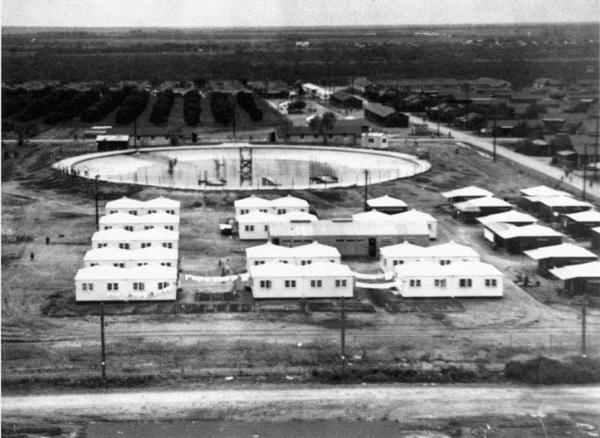
View of Victory Huts, looking south (source: UTSA's Institute of Texan Cultures)
The Third Geneva Convention––Relative to the Treatment of Prisoners of War (1929)––also
applied toward the treatment of Alien Enemies interned in INS camps, monitored by the International Red Cross. These provisions
applied to the amount of food, living space, and clothing that each internee received, often better than the housing and
living conditions of the rationing public in Zavala County, Texas. To comply with international law and promote as positive
an environment as possible, the INS designed the internment camp much like a small community with numerous buildings for
food stores, auditoriums, warehouses, administration offices and a 70-bed hospital, places of worship, a post office, bakery,
barber shop, beauty shop, school system, a Japanese Sumo wrestling ring, and a German beer garten. Internees printed
four camp newspapers: the Crystal City Times (English), the Jiji Kai (Japanese), Los Andes (Spanish)
and Das Lager (German).
Crystal City
Family Internment Camp was staffed by local civilian employees in secretarial and clerical positions, civilian nurses and
doctors, a professional cadre of INS administrators and Border Patrolmen. Later in the war, the INS employed local men from
Crystal City as guards. J. L. O’Rourke was the officer in charge. Under O’Rourke internment camp functions were
allocated to several key divisions: the Administrative Service, Surveillance, Internal Security and Internal Relations [originally
called the Liaison Division], Maintenance, Construction and Repair, Education, and Medical.
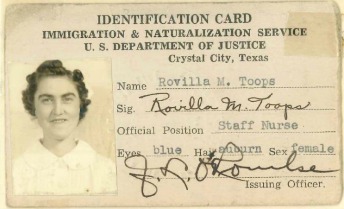
Camp Staff Identification Card (Source: Toops Family Collection)
The
“fenced area” had a 10-foot high barbed wire barrier around the internee section, six guard towers with one located
on each corner and half-way down the west-to-east axis, an armed guard who patrolled the fence line, and an internal security
force patrolling both the Japanese and German sections of the camp.
In accordance with the Third Geneva Convention, no internee had to perform manual labor against their will. For
those who wanted to work, they could earn 10 cents per hour up to a maximum of $4 per week. Jobs ranged from store clerks,
hospital staff, librarians, laundry workers, shoe repairmen, furniture and mattress factory positions, janitors, barbers,
and beauticians. Select internees worked in the INS administration offices. Internees with agricultural experience worked
in the camp’s internal orange orchard, vegetable gardens, and the surrounding agricultural fields dedicated to the
camp. In an effort to prevent internees from stockpiling cash in the event of an escape attempt, camp scrip was issued to
internees. The camp scrip was pressed paper and plastic tokens that resembled coins or poker chips, but were not legal tender.
There were no reported escape attempts, successful or otherwise, from Crystal City Family Internment Camp.
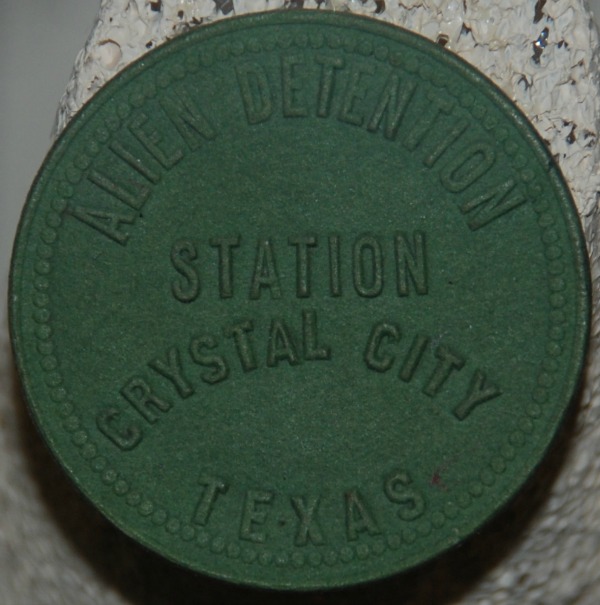
Camp Scrip Token
One of the programs for internees established at Crystal City (Family) Internment Camp was an accredited education
program. Robert Clyde “Cy” Tate was hired to supervise the school system. Prior to joining the staff in 1943,
Tate had served as the Crystal City High School principal. One of Tate’s initial objectives was to recruit qualified
teachers to move to Crystal City and work in the camp’s schools. This was no easy task due to the uncertainty of the
work’s duration and the remoteness of Crystal City. Challenged by the fact that each student was a transfer, Tate
strived to meet state regulations concerning proper textbooks, teaching materials, and classroom space requirements per
pupil.
Tate established three types
of schools: the American (called Federal) School, the Japanese School, and the German School. Each school provided an elementary,
junior high, and high school education. The Federal School offered an American-style education; the Texas State Board of
Education inspected the schools and granted full accreditation for all courses taught. Some graduates eventually went on
to U.S. colleges. Both the Japanese and German schools provided students with a background in their ancestral culture and
language. Both Japanese and German American and Latin American internees served as teachers for non-federal schools and
designed their own curriculum. While meeting the cultural needs of internees, the Japanese and German School systems assisted
future voluntary and non-voluntary repatriates for life––after they were exchanged for U.S. and Allied personnel––in
their ancestral home lands.
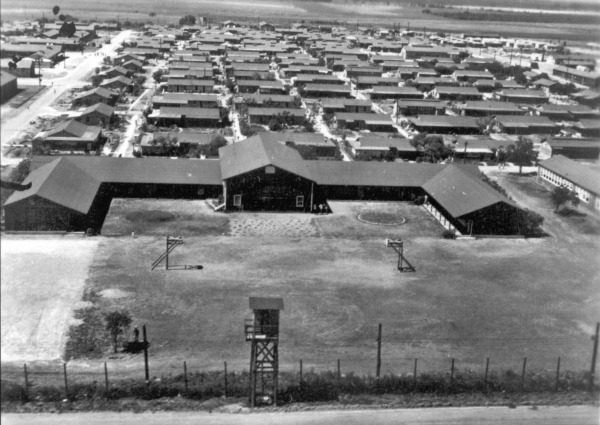
Federal High School looking north (source: Carroll Brincefield)
Federal High School, and its feeder school, Federal Elementary, provided students with both academic and athletic
opportunities. Multiple softball and basketball and two football teams formed between 1943 and 1946, the year the school
system closed. In 1944-1945, Federal High School students produced their own yearbook, the Roundup; published a
school newspaper, the Campus Quill; held a prom; and participated in commencement exercises.
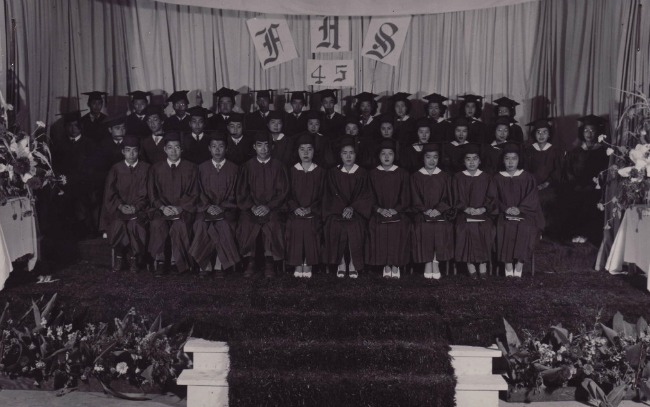
1945 Federal High School Graduating Class (source: NARA RG 85, Entry 276 Box 46 - Folder 602?032)
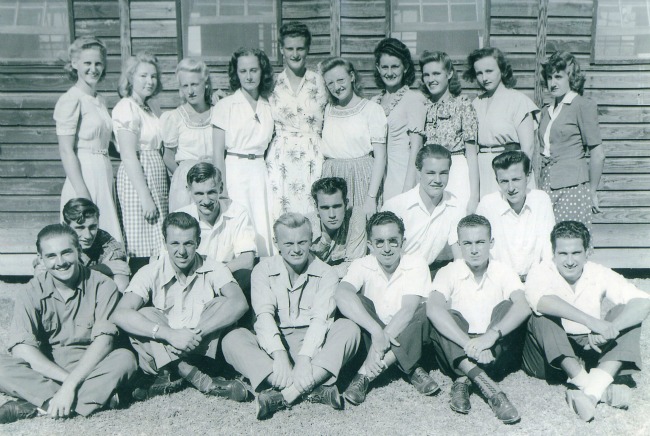
German Student Internees (source: Eb Fuhr)
A source of recreation and community, the camp’s Swimming Pool/Irrigation Reservoir was the camp’s largest
defining feature (minus the security fence) and today is the most extant resource left of this nationally significant site.
The 250-foot-wide-pool was designed by Italian-Honduran civil engineer Elmo Gaetano Zannoni. With German internees providing
the labor, a former swamp was drained, cleared of snakes, expanded and paved over.
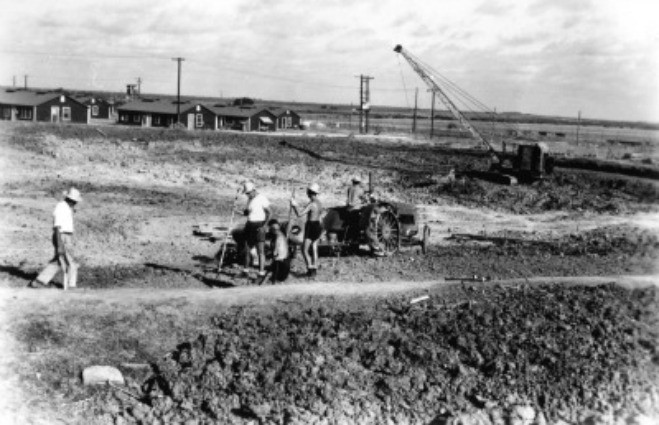
German Internees Building Camp
Swimming Pool (source: UTSA's Institute of Texan Cultures)he German and Japanese bathhouses were built separately to allow
Japanese internees and their German and Italian internee counterparts separate and equal access to the community swimming
pool in congruence with the U.S.’ obligation as a signatory of the Third Geneva Convention, which was applied toward
Alien Enemies and reads, “The Detaining Power shall assemble prisoners of war in camps or camp compounds according
to their nationality, language and customs …”
The pool was enjoyed by children throughout the internment camp, and was a welcome relief from the hot summer sun.
The pool’s deep end was filled-in with dirt after the war and today is distinguishable as a grass half-circle. The
deep end of the pool facilitated three diving platforms. Between the deep end and shallow end are the metal piling remains
of a safety cable that extended across the diameter of the pool, separating deep water from shallow. Tragically, in 1944,
two Japanese Peruvian girls drowned while swimming in the pool when they slipped past the safety cable. Former Japanese
American internee, Bessie Masuda from California (whose family was reunited with her father at Crystal City), commented
in an oral history interview with the Texas Historical Commission on the tragic drowning of two young Japanese Peruvian girls
who ventured into the deep end of the pool, “… I was wading with my friends in the pool and we actually
saw the girl drowning in the deep end of the pool. We all grabbed hands and tried to reach them, but the floor was too slippery
for us. It was so sad that we couldn't help…”
__________________________________
To
the north of the Crystal City Family Internment Camp pool was the temporary Victory Hut section of the camp (see photo above)
where mostly Japanese Peruvians were first quartered upon arriving at the camp. Victory Huts were four sided wooden walled
military tent structures, purchased inexpensively, and erected rapidly for temporary emergency housing. Internee housing
for the most part offered families individual cooking facilities, cold running water, and oil stoves. This section of the
camp served as temporary housing for newly arriving internees as current residing internees were processed out for parole
or repatriation. Many Latin American internees, regardless of nationality, primarily spoke Spanish and had difficulty communicating
in the camp through English, Japanese, and German.
Japanese, German, & Italian Enemy Alien Internment & Repatriation
The interment camp’s population expanded throughout the war, and ultimately consisted
of Japanese (Issei), Japanese Americans (Nisei), German American citizens, German nationals, Italian nationals, as well
as Latin American Japanese, German and Italian, and a small group of Indonesian sailors.
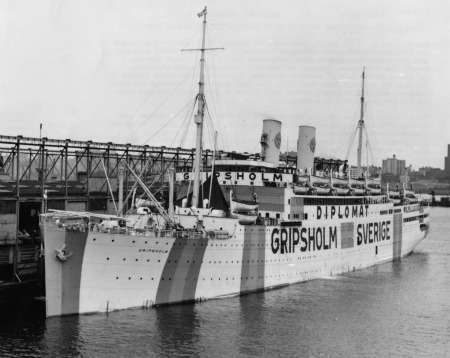
S.S. Gripsholm in New York City (source: NARA RG 59, Box 1)
Leaving the U.S. during a repatriation
voyage (source: NARA RG 59, Box 1 - Folder 4)
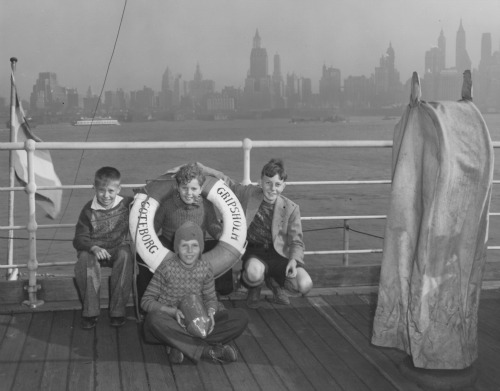
German children internees on board a repatriation voyage (source: NARA RG 59, Box 1 - Folder 5) during the war, the
chartered Swedish ship, the SS Gripsholm sailed from the U.S. with internees from INS camps across the U.S. Two
massive movements from Crystal City took place in February 1944 and December 1944/January 1945. Many of the internees held
at Crystal City were now forced with trying to make a life in Germany or Japan on the brink of collapse as World War II
wound down. By June 30, 1945, with Germany and Italy knocked out of the war, and Japan less than two months away from unconditionally
surrendering to the Allies, Crystal City (Family) Internment Camp still had an internee population of 3,316. As the war
drew to a close, U.S. authorities were faced with the problem of managing the internees still confined across the country.
Part of the problem lay in how the internees should be designated. Those who voluntarily agreed to be sent back to their
country of national origin were considered for possible return to the U.S. in the future. Included in this group were the
American-born children of Axis nationals. The internees who did not volunteer or who were considered dangerous were classified
as deportees and could not return to the U.S. permanently. By December 1945, approximately 1,260 Japanese Peruvians were
exchanged out of Crystal City––600 to Hawaii and 660 to Japan––because Peru would not take them
back after the war. Many Japanese Peruvians had to wait nearly two years after the war ended, caught in a legal limbo before
their release. To that end, the INS encouraged remaining Japanese internees to find a sponsor after parole. A canning and
farming company at Seabrook Farms, New Jersey sponsored and hired the majority of the remaining internees.
___________________________________
The Crystal City Family Internment Camp closed on February 27, 1948, nearly 30 months after the end of the war on
September 2, 1945. In November 1948, the Crystal City Independent School District purchased 90 acres of the camp, primarily
within the fenced area, from the War Assets Administration. To the north and east of the fenced area is where the camp’s
athletic fields were located during the war. In 1952, the city purchased this portion of the camp to establish an airfield.
Today, eight distinct panels––dedicated by the Texas Historical Commission
and the City of Crystal City in November 2011––make up an interpretive trail at the former confinement site.
Heritage tourists looking to learn more about the site should stop by the Crystal City Memorial Public Library
located next to City Hall at 101 E. Dimmit Street and request a copy of the free brochure that accompanies the interpretive
signage project.
To learn more about Texan involvement
in World War II please visit the National Museum of the Pacific War in Fredericksburg.
Oral History Interviews
THC historians have conducted oral history interviews with former Japanese, German, and
Italian (U.S. citizen and Enemy Aliens) interned at the Crystal City confinement site, as well as a number of U.S. citizens
who worked at the camp or lived in Crystal City during World War II. Interview subjects and transcripts for these interviews
are available below. Additional inquiries about this collection should be directed to the Military History Program Coordinator
at militaryhistory@thc.texas.gov.
Seiji Aizawa
U.S. citizen and former War Relocation Authority internee who visited his family while they were held at Crystal
City (Family) Internment Camp during the war. Aizawa Transcript
Heidi (Gurcke) Donald
Former German-Costa Rican whose family was arrested and deported by the Costa Rican government during the war. Her
family was held at Crystal City (Family) Internment Camp beginning in 1943. Donald Transcript
JoAnna Howell U.S.
citizen born in Texas during World War II. The Howell family was taken into custody in Fort Worth in December 1941, separated
from each other, and eventually reunited in Crystal City (Family) Internment Camp. Howell Transcript
Art Jacobs
U.S. citizen from New York held with his family at Crystal City (Family) Internment Camp during the war. He was
exchanged/repatriated to Germany and eventually returned to the United States after the war. Jacobs Transcript
Haru Kuromiya
Japanese American internee from California held along with her family at Crystal City (Family) Internment Camp during
the war. Kuromiya Transcript
Bessie Masuda
Japanese American internee from California. Her family was reunited with her father at Crystal City (Family) Internment
Camp during the war. Masuda Transcript
Audrey Moonyeen (Neugebauer) Thornton
Born in London, England, she and her British mother and German father left Venezuela
during the war for Costa Rica, where they were arrested and deported to the U.S. Her family was interned at Crystal City
(Family) Internment Camp during the war. Thornton Transcript
Elizabeth Yarborough
U.S. citizen born in Texas. She lived and worked in Crystal City during the war and commented on the confinement
site from the perspective of “the other side of the fence.” Yarborough Transcript
Kennedy, Texas
Kenedy Enemy Alien Detention Station

Under different names, organizations, and even two World Wars, Camp Kenedy has had a
long and storied service life. During World War I, the site served as an Army training post. During the Great Depression,
the site served as Civilian Conservation Corps (CCC) Camp #3806. In March 1942, the site was transferred from the CCC to
the Immigration and Naturalization Service (INS), and the Kenedy Alien Detention Camp received its first internees on April
21, 1942.
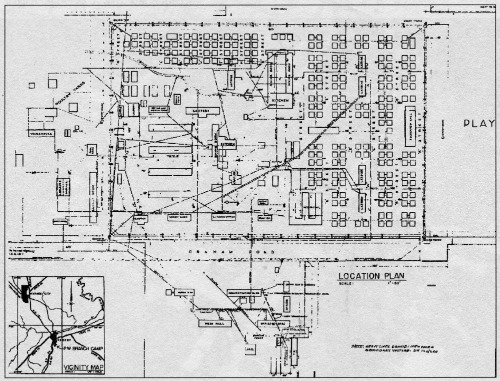
Map of Camp Kenedy after conversion to prisoner of war camp (source: Fort Sam Houston Museum/Judge Robert
H. Thonhoff)
The site was designated to hold detainees that the Department of State brought in from Latin America. The first
internee group from Latin America consisted of 156 six Japanese, 456 Germans, and 14 Italians arrived at the newly converted
INS camp in April 1942. This group was augmented by an additional 355 internees (chiefly of German nationality) who were
received in May, and by 253 Japanese internees in June. The population consisted primarily of adult males and a very small
number of teenage boys. In an effort to provide internees with activities, the camp had large athletic fields 600 feet long
by 450 feet wide and gardening areas outside the barbed-wire fence. Victory Huts were added to the existing CCC buildings
to afford the confinement site with accommodations for 1,200 internees, and a staff of 84 INS and civilian workers. However,
the camp’s population averaged closer to 600 internees per month. Through the remainder of 1942, and the beginning
of 1943, a portion of the detainees were repatriated, while others were reunited with their families at Crystal City (Family)
Internment Camp and Seagoville Enemy Alien Detention Station.
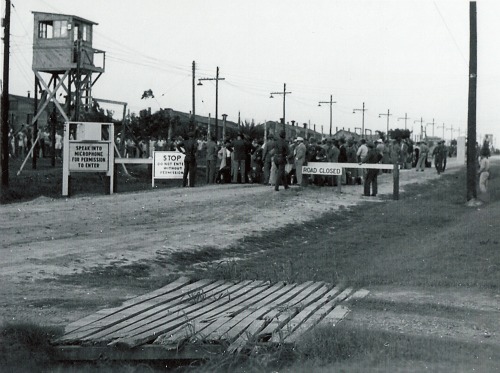
Kenedy Enemy Alien Detention Station main entrance (source: National Border Patrol Museum - El Paso)
By August 1944 Kenedy Enemy Alien Detention Station still held 525 internees; with the exception of 30,
all originated from Latin American countries. According to Protectorate Nations’ inspection visits, the majority of
internees desired repatriation to their home countries or return to the Latin American country from which they were taken
into custody.
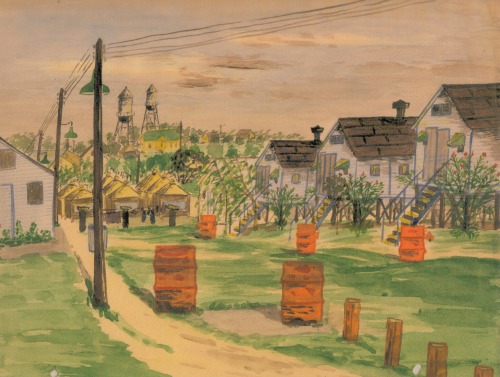
Japanese Enemy Alien Art (Source: Judge Robert H. Thonhoff)
By 1942, the U.S. Army realized it needed to focus the efforts of it's Provost Marshal General's Office on the expected
task of guarding hundreds of thousands of Axis [Japan, German, and Italy] prisoners of war. In response, the DOJ gave the
INS increased authority to house potentially dangerous Enemy Aliens (including U.S. citizens) at internment camps throughout
the U.S. At this point in the war, the U.S. Military needed additional prisoner of war camp space, and the remaining internees
were transferred to other INS camps, paroled, or repatriated. The INS ceased operation of the facility in September 1944.
After the internment camp closed, the site became a German and later Japanese prisoner of war camp, each administered out
of Fort Sam Houston’s base prisoner of war camp.
Japanese,
German, & Italian Enemy Alien Internment
Kenedy
Enemy Alien Detention Station’s internee population volunteered or was “volunteered” for repatriation from
1942 until its closure in August 1944.
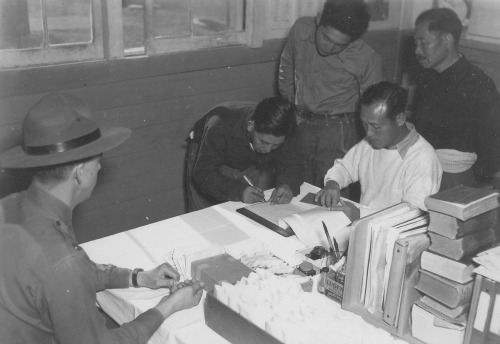
Japanese Latin Americans registering upon arrival at Kenedy (source: Judge Robert H. Thonhoff)
Oral History
Interviews
THC historians have conducted several oral history
interviews associated with Japanese, German, and Italian enemy alien internment at camps located in Texas. Most of these
interviews are with individuals who have links to Crystal City (Family) Internment Camp in Crystal City, Texas. More information
about this camp, and transcripts from those interviews, can be found here. We have one oral history interview related to Kenedy Enemy Alien Detention Station (see below for interview details
and transcript).
Please contact the THC Military History
Program Coordinator directly at militaryhistory@thc.texas.gov for all inquiries related to the agency's oral history collection.
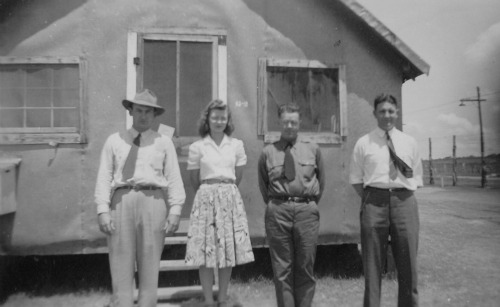
Civilian employees at Kennedy
German American
(U.S. citizen) whose family escaped Nazi Germany during the 1930s and took up residence in Texas. During World War II, recently
graduated from Southern Methodist University, Marianne McCall worked at the Kenedy Enemy Alien Detention Station as an interpreter
and censor. McCall Transcript














